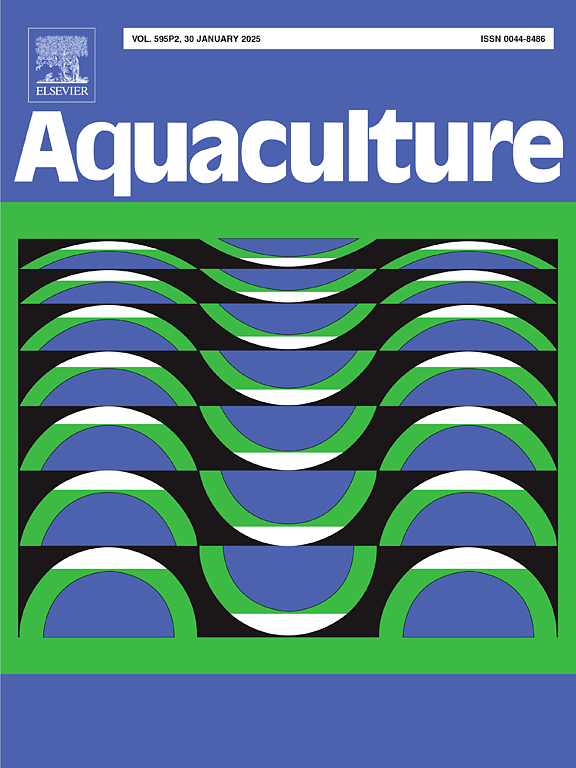Improved coral nursery production through contingent heat stress events via depth manipulation
IF 3.9
1区 农林科学
Q1 FISHERIES
引用次数: 0
Abstract
Ocean-based coral aquaculture is increasingly employed to generate biomass for active coral reef restoration. As this practice expands in scale and global application, it is important to explore techniques that optimize nursery yield amid climate change and dynamic environmental conditions. Therefore, we constructed three suspended coral nurseries in Malaysia to test whether increasing coral nursery depth protects biomass production from detrimental heat stress impacts while assessing potential trade-offs in growth and survival. The study focused on three coral species: Acropora muricata, Acropora cf. gemmifera, and Montipora aequituberculata. One nursery was maintained at the original source material collection depth of 8.0 m (Shallow), another was lowered to a depth of 15 m (Deep), and the third nursery (Transitional) was gradually transitioned from 8 to 15 m over a 71 day period. Coral growth and survival were monitored for 582 days, representing the longest observational nursery study yet reported in Malaysia. In addition, these data capture the impacts of the first back-to-back coral bleaching events recorded in the region, as well as a period of heavy tropical storm activity (i.e., northeast monsoon season). Ultimately, major findings include (1) species-specific differences in growth and survival across nurseries, (2) A. muricata exhibited the highest growth rates (0.28 ± 0.02 % day−1) in the Shallow nursery, while M. aequituberculata had the lowest (0.16 ± 0.02 % day−1) in the Deep nursery, (3) survival was the highest at 15 m, with A. gemmifera displaying the greatest survival rate (88 %), and (4) significantly lower heat stress response and bleaching in corals cultured in deeper nurseries. These results suggest that depth manipulation could be a viable strategy for mitigating heat stress impacts in coral nurseries while maintaining favorable biomass production. This study provides key insights for optimizing coral restoration efforts in the Indo-Pacific, where climate change increasingly threatens coral reefs.
基于海洋的珊瑚水产养殖越来越多地用于产生生物量,以积极恢复珊瑚礁。随着这种做法的规模扩大和全球应用,探索在气候变化和动态环境条件下优化育苗产量的技术非常重要。因此,我们在马来西亚建造了三个悬浮珊瑚苗圃,以测试增加珊瑚苗圃深度是否能保护生物量生产免受有害热应力的影响,同时评估生长和存活率方面的潜在权衡。这项研究主要针对三个珊瑚物种:Acropora muricata、Acropora cf. gemmifera 和 Montipora aequituberculata。一个苗圃保持在原始材料采集深度 8.0 米(浅层),另一个苗圃降低到 15 米(深层),第三个苗圃(过渡层)在 71 天内逐渐从 8 米过渡到 15 米。对珊瑚的生长和存活进行了长达 582 天的监测,这是马来西亚迄今为止报告的最长时间的观察育苗研究。此外,这些数据还捕捉到了该地区有记录以来首次连续发生的珊瑚白化事件以及强热带风暴活动期(即东北季风季节)的影响。最终的主要发现包括:(1)不同育苗场的珊瑚物种在生长和存活率方面存在差异;(2)浅海育苗场中 A. muricata 的生长率最高(0.28 ± 0.02 % day-1),而 M. aequituberculata 的生长率最低(0.16 ± 0.02 % day-1);(3) 15 米处的存活率最高,其中 A. gemmifera 的存活率最高(88%);(4) 在较深的育苗池中培养的珊瑚的热应力反应和白化现象明显较低。这些结果表明,深度控制可能是一种可行的策略,既能减轻珊瑚育苗过程中的热应力影响,又能保持良好的生物量生产。在气候变化日益威胁珊瑚礁的印度洋-太平洋地区,这项研究为优化珊瑚修复工作提供了重要启示。
本文章由计算机程序翻译,如有差异,请以英文原文为准。
求助全文
约1分钟内获得全文
求助全文
来源期刊

Aquaculture
农林科学-海洋与淡水生物学
CiteScore
8.60
自引率
17.80%
发文量
1246
审稿时长
56 days
期刊介绍:
Aquaculture is an international journal for the exploration, improvement and management of all freshwater and marine food resources. It publishes novel and innovative research of world-wide interest on farming of aquatic organisms, which includes finfish, mollusks, crustaceans and aquatic plants for human consumption. Research on ornamentals is not a focus of the Journal. Aquaculture only publishes papers with a clear relevance to improving aquaculture practices or a potential application.
 求助内容:
求助内容: 应助结果提醒方式:
应助结果提醒方式:


